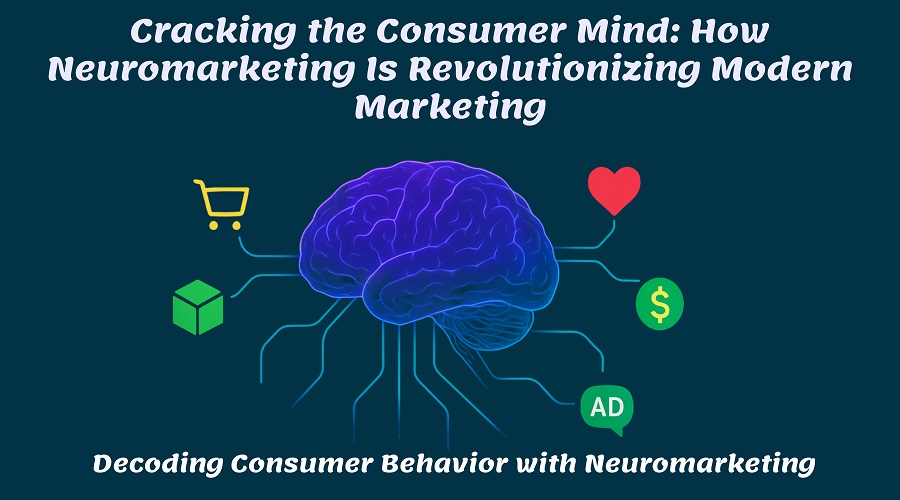Ever wonder why some ads feel like they get you while others completely miss the mark? It’s not just creativity at play; it’s science. Neuromarketing taps into the psychology and neuroscience behind consumer behavior, offering brands a powerful edge.
As businesses fight for attention in crowded markets, those using neuromarketing are gaining a deeper understanding of what truly drives buying decisions and how to influence them.
What Is Neuromarketing, Exactly?
Neuromarketing is the application of neuroscience and psychology to marketing strategies. Instead of relying solely on focus groups or surveys, neuromarketing uses tools like eye tracking, EEG (electroencephalography), and fMRI (functional magnetic resonance imaging) to measure a consumer’s subconscious response to stimuli such as ads, packaging, colors, or product placement.
It moves beyond what consumers say to uncover how they feel helping brands craft messaging and experiences that resonate on a deeper emotional level.
The Science Behind Neuromarketing
At its core, neuromarketing explores how the brain processes:
- Emotion: Humans are emotional beings. Emotional branding can create stronger, longer-lasting customer connections.
- Attention: Our brains are wired to notice contrast, movement, faces, and color. Marketers use these triggers to guide visual focus.
- Memory: Effective campaigns tap into long-term memory encoding, increasing brand recall over time.
- Decision-Making: Most purchasing decisions are subconscious. Neuromarketing decodes those automatic thought processes.
With insights drawn from cognitive psychology and neuroscience, marketers can tailor their content and campaigns to align more closely with how the brain reacts not just how consumers report feeling.
Practical Applications of Neuromarketing in Business
1. Product Packaging & Design
The way a product looks directly influences purchase decisions. Neuromarketing research shows that visual symmetry, color psychology, and tactile cues can trigger pleasure responses in the brain. Brands like Coca Cola and Apple use sleek, symmetrical design and consistent color schemes to boost appeal.
2. Website Optimization
Where do your visitors look first? What makes them click or bounce? Tools like eye tracking and heatmaps are rooted in neuromarketing. Strategic placement of buttons, headlines, and product images can reduce friction and drive conversions.
3. Ad Testing
Using biometric feedback like pupil dilation or heart rate, brands can test different ad versions to see which truly engages or emotionally connects with viewers. This data is far more reliable than simply asking, “Did you like it?”
4. Pricing Strategies
Pricing isn’t just about numbers it’s psychological. The “$9.99 effect” or bundling techniques are classic neuromarketing strategies that subtly influence buyer perception of value.
Neuromarketing in Action: Real-World Examples
- Pepsi vs. Coca-Cola: A famous neuromarketing study found that while blind taste tests favored Pepsi, brain scans showed stronger emotional responses to Coca-Cola branding explaining Coke’s market dominance.
- Amazon: The e-commerce giant applies neuromarketing principles like urgency (“Only 2 left in stock!”) and social proof (“People also bought…”) to drive sales psychology.
- Google Ads: Neuromarketing data has helped refine ad copy and visual placements to match users’ scanning patterns resulting in higher engagement and click-through rates.
These examples show that neuromarketing isn’t futuristic theory it’s already shaping the most successful strategies today.
Should Your Brand Invest in Neuromarketing?
While some tools like fMRI scans are costly, there are scalable neuromarketing techniques accessible to businesses of all sizes:
- A/B testing emotional vs. rational copy
- Using color theory in branding
- Applying F-pattern or Z-pattern layouts on web pages
- Leveraging storytelling to activate emotional brain regions
In an era where attention is scarce and trust is hard-earned, understanding your audience on a neurological level is one of the smartest moves a marketer can make.
Final Thoughts: The Brain Is the New Battleground
As consumer expectations evolve, so must the strategies used to reach them. Neuromarketing is more than a trend it’s a shift in how we approach branding, advertising, and UX. By decoding the brain’s hidden triggers, marketers can create campaigns that are not only more effective but also more meaningful.
Your audience may not remember every detail of your ad, but they will remember how it made them feel. That’s the neuromarketing advantage.
Unlocking the power of neuromarketing in research requires precision and clarity. With the right Research Assistant, you can focus on exploring consumer behavior while getting reliable academic guidance. Professional Synopsis Writing support ensures your study is well-structured and impactful. Take the step toward stronger research outcomes by combining your ideas with expert assistance that refines, organizes, and amplifies your work.
FAQs
Q1: Is neuromarketing ethical?
A: Yes when used responsibly. Neuromarketing aims to better understand consumer behavior, not manipulate it. Ethical use focuses on enhancing user experience and delivering value, not exploiting vulnerabilities.
Q2: Do I need a big budget to use neuromarketing?
A: Not necessarily. While advanced tools like EEG and fMRI are expensive, many neuromarketing principles like color psychology, emotional storytelling, and layout strategies can be applied with minimal cost.
Q3: What industries benefit most from neuromarketing?
A: Any industry that involves customer engagement: retail, tech, healthcare, education, entertainment, and especially advertising. Brands across sectors are using neuromarketing to increase impact and loyalty.
Q4: How does neuromarketing differ from consumer psychology?
A: Consumer psychology relies on observed behavior and self-reporting. Neuromarketing goes a step further by measuring biological and neural responses to better understand subconscious reactions.
Q5: Can neuromarketing help increase sales?
A: Absolutely. By aligning marketing strategies with how the brain responds, companies can boost engagement, reduce decision fatigue, and improve conversion rates ultimately leading to increased sales.





Comments